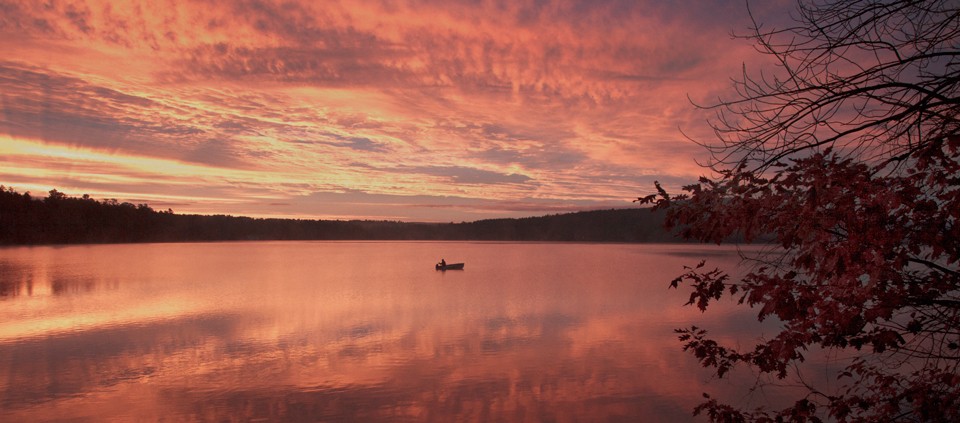The Transformative Power of Awe

by Janet Arnold-Grych
A lot of us could probably use a little more awe in our lives. And it’s not just because awe often comes packaged with a lovely landscape. Research is uncovering more about the amazing power of awe to inspire us, connect us, and keep us well.
We all have those moments when awe stops us in our tracks. A few years ago, I had dropped off my son at the high school’s team bus in the pre-dawn chill of a Saturday morning. On a lark, I drove to the lake. Grabbing the extra stadium blanket from the back of the car, I walked down the path toward the beach. I remember nodding to others on the path: a man and his young daughter, an older couple, random joggers. We took our respective spots and waited for the sun.
Slowly the colors emerged and mixed, opening at last for the brilliant glow we’d all come to witness. No one spoke. Only after the house lights fully came up in the sky did anyone stir. Watching the sunrise felt sacred, as did the ineffable kinship developed with those who’d stood with me. I walked away thinking about the people who, thousands of years ago, had stared at the same sun, and imagined they felt the same transcendence, connectedness, and awe.
Researchers point to two distinct qualities of awe that differentiate it from other positive emotions, such as happiness or gratitude. Awe holds a feeling of vastness and it is bigger than our understanding of the world. There is almost a magical quality to it that shifts us from focusing on our small selves to embracing, if only for a time, a broader connection.
Interestingly, rather than feeling insignificant in the face of such magnificence, it seems we are fed by it and become more aware of our connection to others. Studies conducted at Berkeley and elsewhere suggest that when exposed to pictorial or actual views of natural beauty, we are more likely to offer assistance to someone in need or to engage in acts of kindness. Our view expands from “me” to “we.” For this reason, it is speculated that awe may be a tool that has helped us, as a species, to work together and survive.
Awe also expands our creativity. When simply happy, we tend to rely more on what we already know when generating ideas. When fueled by awe, we are more likely to step through those filters, transforming information and generating new thoughts and solutions.
If that weren’t enough, awe goes beyond feeling to physiology. Negative emotions have been shown to increase levels of inflammatory proteins called cytokines; and higher cytokines levels have been linked to a variety of diseases, including diabetes, cardiovascular disease, and depression. Experiences of awe, as opposed to happiness or peacefulness, are more likely to promote healthy levels of cytokines.
Science would appear to suggest we should immerse ourselves in national forests, oceans, and mountaintop views. Those infusions of grandeur may be important, but they don’t need to be our only source. We can tap into the awe in smaller moments, if we notice them. “A large part of it all is presence—being present to the present,” says Maria Sirois, PsyD, a Kripalu faculty member. “Miracles are all around but we need to be open to them. You can be in the redwood forest and simply see it as a highway of trees or go to the beach and not feel anything. What are you really seeing, experiencing? I am reminded of the Henry Miller quote, ‘The moment one gives close attention to anything, even a blade of grass, it becomes a mysterious, awesome, indescribably magnificent world in itself.’ That is where we find awe.”
This focus on awareness would suggest that even those of us city- and responsibility-bound can consciously invite in awe. We can marvel at the sky or the sunlight on the trees. We can be swept up in music, art, architecture, nature ... whatever offers that transformative experience and feeds our sense of vastness and mystery. And that is a very personal thing.
“There are certain elements that are life giving,” explains Maria, “and that varies from person to person. I’m thinking of two women I know who are avid birdwatchers. They can see a robin and find it a universe unto itself. I can see that same bird and have little reaction to it. I am moved by Rumi and I've read some of his poems 100 times. Each time I feel as if a doorway is opening inside. I am both more connected to myself and to something larger. Awe is paying attention to what is very personal to you.”
Like my experience with the sunrise, when we step into those moments of awe, we find there is an immersion, a settling. Time falls away. That experience can be easily classified as yogic. “Yoga at its best opens a deep connection to the present moment,” says Maria. ”It reminds us that this is what miracles looks like, what love looks like.”
The desire and appreciation for experiences that are vast and beyond our understanding lies in our bones. It is common to the human experience and reminds us that we are part of the beauty we see, part of the tribe that sees it. Consciously feeding our sense of awe, whether in larger moments or through smaller reminders, enhances our well-being and brings us into greater presence with ourselves and those who may, or may not, be standing beside us. And we could all use a little more of that.
Janet Arnold-Grych is a yoga teacher and writer whose work has been published in Elephant Journal, Huffington Post, Third Coast Digest, and other outlets.
Find out about programs with Maria Sirois at Kripalu.
© Kripalu Center for Yoga & Health. All rights reserved. To request permission to reprint, please e-mail editor@kripalu.org.